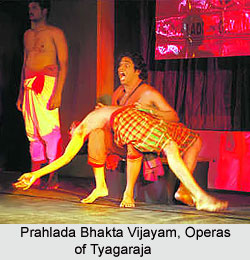 There are two main operas written by the famous Carnatic music composer Tyagaraja. These are `Nowka Charitram` and `Prahlada Bhakta Vijayam`, also known as `Prahlada Bhakti Vijayam`. He had given a brilliant touch to these musical plays. He had written another less known opera named `Sitarama Vijayam` and it cannot be found now.
There are two main operas written by the famous Carnatic music composer Tyagaraja. These are `Nowka Charitram` and `Prahlada Bhakta Vijayam`, also known as `Prahlada Bhakti Vijayam`. He had given a brilliant touch to these musical plays. He had written another less known opera named `Sitarama Vijayam` and it cannot be found now.
Prof P. Sambamoorthy, a yesteryear musicologist admired Tyagaraja for his beautiful compositions and the two famous operas. He described Tyagaraja as the `Geya Nataka Margadarsi`, which means `Trailblazer of Musical Drama` after watching these two operas by him. Tyagaraja, although was not the pioneer of this art form but he came out with many undiscovered dimensions in his operas. Sambamoorthy referred him as the greatest writer of operas.
Tyagaraja was a famous devotee of Lord Rama. So, when made his mind to try his hand in operas, he dedicated one of them to Krishna and the other to the child devotee Prahlada. All these operas are a combination of musical excellence and literary worth. The conversations of these plays include both direct and the indirect speech. One can see the mudra (signature) of Tyagaraja in each of the songs and repetition of ragas is also common in them.
The Nowka Charitram is a one-act opera. The verses of this opera are mainly in Telugu apart from few colloquial touches in few parts. This opera was presented in a combination of verse, prose and song. It has five scenes, which tells about the story of a boat excursion on the River Jamna. The boat consists of Krishna, who is shown as a boy of 7 years and twenty Gopis. There is no real base of the story of this opera. It is just based on the imagination of Tyagaraja to captivate the interest of the people. The Nowka krida shown in this opera does not exist in any sacred lore or even in Bhagavatam. Tyagaraja wanted to communicate mankind the supreme teachings that there exists a Supreme and eternal power which is always following the destinies of man. And he also focused that being unmindful to that eternal power can place one into trouble. In this opera Tyagaraja tried to portray the `madhura bhakti` aspect. The `sringara` (love) emotion is also predominant in this opera. The main theme of the opera is to surrender before the Supreme Lord. In present day, this opera has been published with a critical introduction notes and notation.
The second opera of Tyagaraja, the `Prahlada Bhakti Vijayam` consists of five acts and it is the longest of the three operas he composed. This comprises of total forty-five songs in 28 ragas and there are 142 verses in a variety of metres. The story of this opera is also different from the storyline of the `Bhagavatam`. In this opera, the Bhakti of Prahlada for his Lord Vishnu is the main theme. The Act two of the opera is very surprising. In the first song of that part, he identified Hari or Vishnu with Lord Rama without bothering about the fact that Rama was a later incarnation to Narasimha and Rama did not exist at the time of Prahlada. Moreover, the name of Narasimha, who saved Prahlada from his `Asura`, cannot be found in any part of the opera.
In this opera of Tyagaraja, numerous sloka were used from Kulasekhara Azhvar`s Mukundamala and Valmiki Ramayana. Apart from this, some of the original Sanskrit verses were also used in the opera. There are three songs in this opera of which the first one is in raga `Ghanta`, which can be seen at the end of the fourth act while the other two `Mohanam` and `Saurashtram` appear at the end of the final act. The songs of the Prahlada Bhakti Vijayam are popular on the concert platforms like Sri Ganapatini in Saurashtram, Vasndevayatiim and Narada-nuini Vedalina in Pantuvarali. The style of Divyanama kirtanas is used in this opera. The use of beautiful `kanda padyas`, `sisa padyas`, `utpalamalas`, `champakamalas` and `dvipadas` is also visible in this. In the Act II, the description of the greatness of Vaikuntha can also be seen through the churnika `Jayatujayatu Sakala Nigamagama`. This churnika shows the divine glory of Vaikuntha and its grand construction. Tyagaraja referred Lord Rama as the Parabrahma in this opera. The song 21, which is in Devagandhari raga, contains high philosophy.
The other lesser-known opera of Tyagaraja was the `Sitarama Vijayam`, which is lost now. In 1868, the uncovered text of this opera was published in Madras by Narayana Sastrulu. It is said to be the first opera, Tyagaraja attempted to compose. It is based on the story of `Uttara Ramayanam`. In this opera, it is shown that Rama is addressing his brother Satrugna on `Yuddha dharma` before the later`s departure with the horse on the eve of the performance of Asvamedha yajna. Rama also says that Satrugna should not fight with an enemy at night and he should never kill the enemy while he is in sleep. Tyagaraja added one imaginary character named Lakshmi Nidhi in this opera. This person contradicts Rama saying, `As if you yourself practiced all these dharmas! How did you kill Vali? What was the justification of killing Tataki?" This part is written in a very interesting way. There is a famous song in `Keadaragaula` raga and `Adi` tala is sung in the `Vanajanayanudani` part. Sita`s sakhi addresses this song to her when she is made to leave for the forest after the `Pattabhisehka`. This is a very emotional song and Rama is accused in this song for his immovable attitude.
Tyagaraja was the only composer to write musical plays amongst the Trinity.




